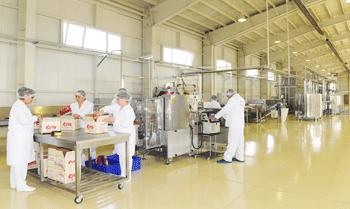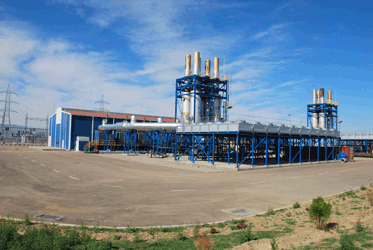Industry
In the Nakhchivan Autonomous Republic the great achievements are attained in the field of industry as well.
Historically the industry of the Nakhchivan Autonomous Republic has held one of the leading parts in the Azerbaijan economy. This important field mainly combined of food, light and other industry areas entered a more intensive development path since the middle of the twentieth century. All of rock salt, molybdenum, zinc, lead produced in Azerbaijan, most parts of mineral waters, raw silk, building materials, marble, wine, fruit, canned jams accounted for a large part of the autonomous republic.
The convenient business environment substantially expedites the emergence of new corporate bodies and individuals, and the growing of economic enterprises.
The Nakhchivan AR is holding the first place amongst the 10 economic regions (rayons) of the Republic of Azerbaijan according to the industrial goods growth rate, the specific weight of non-governmental sector in general industrial production and the minimization of ready produce remnant.
 Recently, industrial enterprises have been engaged in the manufacture of products in the autonomous republic such as bakery products, flour, meat and dairy products, poultry, pasta, tea, sugar, salt, sweets, fruit juice, alcoholic beverages, pasteurized and packaged honey, roasted and packaged agricultural products, mineral waters , decorative stones, travertine cladding stones, plastic materials, lime, alm, marble, different kinds of furniture, cast-iron, and non-ferrous metal refineryand so on.
Recently, industrial enterprises have been engaged in the manufacture of products in the autonomous republic such as bakery products, flour, meat and dairy products, poultry, pasta, tea, sugar, salt, sweets, fruit juice, alcoholic beverages, pasteurized and packaged honey, roasted and packaged agricultural products, mineral waters , decorative stones, travertine cladding stones, plastic materials, lime, alm, marble, different kinds of furniture, cast-iron, and non-ferrous metal refineryand so on.
Output of mineral resources holds a special place in Nakhchivan. Industrial rock salt, dolomite, travertine, tuff, limestone, marble, gypsum, clay, sand, marl, zinc - lead, molybdenum, copper, molybdenum, gold, and rich natural resources, such as mineral water in the autonomous republic of different types of building materials, including reinforced concrete, brick, travertine, marble and other products, and the expansion of production of products available in the world market for the favorable conditions.
The declaration of the "Industrial Year" in the autonomous republic in 2022, has created conditions to promote competitive and export-oriented production in the industrial sector, establish new enterprises based on innovation, and manufacture new types of products.

Production and service facilities in various sectors of economic activity were established on 89 projects in the Nakhchivan Autonomous Republic during the period from January to September 2022, with state support, Furthermore, the creation of production and service facilities under 60 projects continued during this period.
For the development of the industry, economic entities were provided with loans by banks and credit organizations in the Nakhchivan Autonomous Republic, amounting to 9,792,700 manats during the period from January to September 2022. This represents an increase of 13.6 percent compared to the same period in the previous year.
Within the framework of the "State Program for the Socio-Economic Development of the Nakhchivan Autonomous Republic for 2019-2023," measures have been continued to ensure the sustainable development of the autonomous republic's economy, create sectors that utilize local resources and raw materials, and produce export-oriented products. During the reporting period, the establishment of 62 sectors has been completed. Currently, efforts are underway to establish sectors such as industrial zones, salt production facilities, alcoholic beverages production, oxygen production, automobile repair, vegetable oil production, yarn production, dairy processing facility, bakery and confectionery production, refrigerated warehouse, carpet manufacturing, livestock farming, poultry farming, gardening, and various services, totaling 33 sectors.
In 2023, the volume of industrial production in Nakhchivan amounted to 593.9 million manats. In the same year, the Entrepreneurship Development Fund of the Nakhchivan Autonomous Republic provided state financial support of 6.2 million manats on preferential terms for the financing of 40 investment projects, of which 84.8 percent was directed towards the production of industrial goods.
